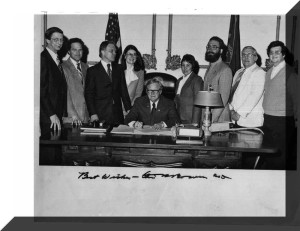Please find below the story that most Hoosiers will read about Doc Bowen from this morning's front page of the Indianapolis Star. But the photo above taken in 1980 as a bill signing ceremony commemorating a 25% state income tax credit for solar and renewable energy in Indiana is how I remember Governor Bowen.
The passage of this state income tax credit was my first legislative victory as an advocate for solar and renewable energy in the Hoosier state. That's me standing just to the left of Governor Bowen who is seated in the middle of the photograph. To my left is then Indiana State Senator John Mutz (R-Indianapolis) who would later become Lt. Governor serving under former Indiana Governor Robert Orr. The other two people to the left of Mutz are State Senator John Augsburger (R-Syracuse) and State Rep. Walt Roorda (R-DeMotte) who died in 1993.
How do you remember Governor Doc Bowen? Please share your stories with us here at IndianaDG.
Former Indiana Gov. Otis Bowen, who fought for tax relief, AIDS funding, dies
Written by Jill Disis May 6, 2013 | 10 Comments
Otis “Doc” Bowen, the small-town doctor who succeeded in providing property tax relief as Indiana governor in the 1970s and then became one of the first federal officials to seek funds to battle the AIDS epidemic in the 1980s, has died.
He was 95.
Bowen passed away at 6:18 p.m. Saturday in Donaldson, Ind., at the Catherine Kasper Life Center, a retirement community 20 miles from his hometown of Bremen.
The Republican was elected governor in 1972, serving two terms from 1973 to 1981. In 1985, President Ronald Reagan appointed him as U.S. Secretary of Health and Human Services, a position he held until 1989.
“Governor Otis R. Bowen’s contributions to the life of this state and nation are incalculable, and I mark his passing with a sense of personal loss,” said Gov. Mike Pence in a news release. “His story is as inspiring as it is uniquely Hoosier.”
Born in Fulton County near Rochester, Ind., the “simple country doctor” had shown an interest in medicine and public service from a young age.
After graduating from Indiana University-Bloomington’s School of Medicine in 1942, “Doc” Bowen enlisted in the Army Medical Corps and served in the Pacific during World War II, reaching the rank of captain.
When the war ended, he moved home to Bremen, Ind., and in 1952 was elected Marshall County coroner.
That job sparked a long political career for Bowen, who also served 14 years in the Indiana House of Representatives — five as speaker of the House.
Bowen became the 44th governor of Indiana in 1973, and was the first since 1851 to serve two consecutive terms in office after a change in the state constitution.
He was credited with controlling the growth of property taxes, while shifting the Hoosier tax burden to sales and income taxes, a plan he told Hoosiers would be “visible, lasting and substantial.”
Bowen made state-backed property tax relief his top campaign pledge as those taxes had more than doubled in the previous decade. Legislation passed the next year doubled the sales tax to 4 percent and dedicating the extra revenue to property tax cuts. The proposal was so hotly contested that it only passed the state Senate when Bowen’s lieutenant governor, Robert D. Orr, cast a tiebreaking vote.
In addition to his property tax control program, Bowen also pushed through limits on the cost of medical malpractice insurance to doctors. That action limited the amount a patient could recover and required the patient to first have the case reviewed by a state panel before filing a lawsuit.
Confronted AIDS epidemic
Bowen was appointed secretary of HHS by Reagan in 1985, serving as the nation’s chief medical officer and championing the cause of securing more funding for AIDS, after the Reagan administration had been criticized for not doing enough to focus the public’s attention and resources on the growing disease.
“Probably not enough was done early,” Bowen told The Star after Reagan’s death in 2004. He was credited with working to speed the approval of new drugs, particularly those designed to fight AIDS. During Bowen’s stint in the Cabinet, the first drug designed to combat AIDS — AZT — gained federal approval.
Although a Republican, Bowen’s appointment as secretary of HHS was opposed by conservative religious groups, because while Indiana’s governor, he had vetoed legislation that would have restricted the right of a woman to seek an abortion.
For Bowen, according to one observer of that fight, “abortion was not a moral issue. It was a medical issue.” However, as head of Health and Human Services, Bowen went along with a Reagan White House plan to prohibit federally funded family planning clinics from dispensing any information concerning abortion. The U.S. Supreme Court in 1991 upheld that power in a celebrated court battle over abortion rights.
Bowen also fought a winning — but ultimately a losing —battle to get Medicare coverage extended to seniors with catastrophic illnesses. Congress passed the proposal in June 1988, but it was repealed a year later after an outcry from Medicare recipients who saw their premiums rise.
Bowen’s time in the Cabinet was his last in a major political office. But he didn’t leave the spotlight completely.
In 2008, 35 years after the property tax legislation he championed passed, he publicly announced his support of similar tax cap legislation proposed by then-Gov. Mitch Daniels.
“I see an opportunity today for Mitch Daniels and our elected senators and representatives to finish the job we started in 1973 by providing real and permanent property tax relief to Hoosiers with strong safeguards to prevent future spending increases,” Bowen wrote in a 2008 editorial printed in The Star.
Daniels’ tax cap legislation became law that year, and in November 2010, Hoosiers voted to make property tax caps an amendment to the constitution.
Twice widowed
The cause of Bowen’s death has not been released.
Ray Rizzo, a former speechwriter for Bowen who served as a legislative assistant throughout many of his years in Indiana government, said he last saw Bowen about a year ago.
“He was in good spirits,” Rizzo said. “We had a great time reminiscing.”
Bowen outlived two of his wives, Elizabeth “Beth” Steinmann Bowen and Rose May Hochstetler Bowen. He is survived by his wife, Carol, his sons, Richard H., Timothy R., and Robert O. Bowen, and his daughter, Judith I. McGrew.







